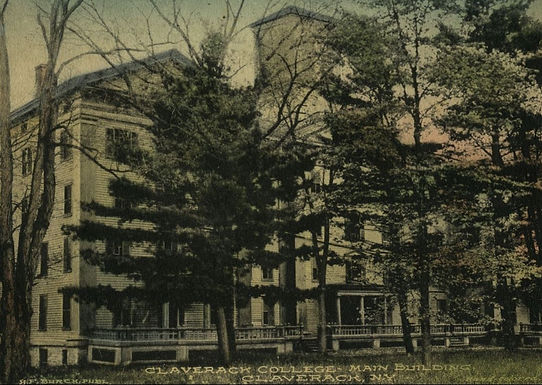Claverack College and Hudson River Institute
Claverack, New York
1779-1902
E-Travel
An early history of Claverack College and Hudson River Institute by Captain Franklin Ellis has been digitized by us.gennet.org. In “Stephen Crane at Claverack College: A New Reading,” Thomas A. Gullason describes the cultural/intellectual life of the college. The logo is courtesy of Chester Historical Society.

History
Claverack College was begun as Washington Seminary, founded by Reverend John Gabriel Gebhardt of the Dutch Reformed Church. He instructed the sons of some of the best families in Latin, Greek and mathematics. In 1830 Claverack Academy was built, and in 1854 it took the name of Claverack College and Hudson River Institute. This school had an average attendance of 300 students, taught by a faculty of 18. By 1891 female students outnumbered males.
Male students were required to have military training at the college, while females had daily drills in Lewis Gymnastics.
According to Ellis, the curriculum featured eleven departments: “classical, French, German, English, normal, musical, painting, military, commercial, telegraphic, and agricultural.” The students were divided into six “forms” based on age and culture; thus allowing each student to receive whatever help was needed. Claverack College was licensed by New York Board of Regents to offer a curriculum leading to a “Mistress of Arts” degree.
A future President of the United States, Martin van Buren, attended Claverack, as did women's reproductive rights pioneer Margaret Sanger. Gullason notes that Stephen Crane was able to enjoy a culturally enriched stay at Claverack with concerts, lectures, the Society for Christian Endeavor, no fewer than seven literary societies (three for women) and the monthly student literary publication The Vidette, for which he wrote pieces.
In a 2003 posting on COLUMB-L Archives, Ruth Piwonka attributes the closing of Claverack College in 1902 to a change in educational trends.

Bricks and Mortar
Claverack College occupied an elevated twenty-acre campus with the Catskill Mountains only eight mikes away. The building, erected in 1830, was a four-story structure with 146 student rooms, thirteen rooms for teachers, 12 lecture and recitation halls, twenty-eight music, literary society, and reading rooms, a library, a chapel, offices and 35 rooms for domestic staff. It also contained a gymnasium, a drill hall, and an armory. It was renovated in 1854.
When the college closed in 1902, the buildings were razed. George Felpel purchased part of the property and used stone from the buildings to erect his own residence there. Designed by architect Henry Mouls and completed in 1922, the Felpel house is on the National Register of Historic Buildings.
New York Heritage Digital Collections, Claverack Free Library, Claverack College Main Building,
Sports
Claverack College played both baseball and football in the 1890’s, though we have few results today, suggesting limited scheduling. According to the New York Tribune, the 1893 baseball team played in “new suits.” With his interest in military matters, Stephen Crane became a captain—the highest ranked cadet at Claverack. But he was interested in baseball and tennis; Gullason describes him as the star of the baseball team.
In 1892 the football team defeated Hudson Athletics 16-0 and again in 1894 by a score of 6-0. The New York Herald-Tribune says that the 1894 team “lost only once.” The 1895 team opened against City of Hudson High School, winning 24-0. College Football Data Warehouse shows two games—both victories—in 1900 against Troy Academy and against New Paltz Normal

Stephen Crane at age 17 (<en.wikipedia.org/wiki/ClaverackCollege#/media/File:Craneinuniform.jpg>) accessed 1-27-2017
Note: Images are used in accordance with their “terms of use” as I understand those terms. Recopying or republishing these images may be restricted or forbidden.